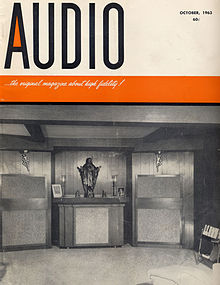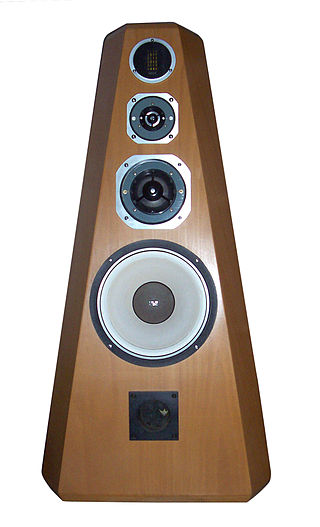
High fidelity is the high-quality reproduction of sound. It is popular with audiophiles and home audio enthusiasts. Ideally, high-fidelity equipment has inaudible noise and distortion, and a flat frequency response within the human hearing range.
An audiophile is a person who is enthusiastic about high-fidelity sound reproduction. An audiophile seeks to reproduce recorded music to achieve high sound quality, typically in a quiet listening space and in a room with good acoustics.
Bose Corporation is an American manufacturing company that predominantly sells audio equipment. The company was established by Amar Bose in 1964 and is based in Framingham, Massachusetts. It is best known for its home audio systems and speakers, noise cancelling headphones, professional audio products and automobile sound systems. Bose has a reputation for being particularly protective of its patents, trademarks, and brands.
High Fidelity — often abbreviated HiFi — was an American magazine that was published from April 1951 until July 1989 and was a source of information about high fidelity audio equipment, video equipment, audio recordings, and other aspects of the musical world, such as music history, biographies, and anecdotal stories by or about noted performers.
PS Audio is an American company specializing in high-fidelity audio components equipment for audiophiles and the sound recording industry. It currently produces audio amplifiers, preamplifiers, power related products, digital-to-analog converters, streaming audio, music management software and cables.
High-end audio is a class of consumer home audio equipment marketed to audiophiles on the basis of high price or quality, and esoteric or novel sound reproduction technologies. The term can refer simply to the price, to the build quality of the components, or to the subjective or objective quality of sound reproduction.
Robert W. (Bob) Carver is an American designer of audio equipment based in the Pacific Northwest.
Stereophile is a monthly American audiophile magazine which reviews high-end audio equipment, such as loudspeakers and amplifiers, and audio-related news.

Rudolph Thomas Bozak (1910–1982) was an audio electronics and acoustics designer and engineer in the field of sound reproduction. His parents were Bohemian Czech immigrants; Rudy was born in Uniontown, Pennsylvania. Bozak studied at Milwaukee School of Engineering; in 1981, the school awarded him an honorary doctorate in engineering. Bozak married Lillian Gilleski; the two had three daughters: Lillian, Mary and Barbara.
Sound & Vision is an American magazine, purchased by AVTech Media Ltd. (UK) in March 2018, covering home theater, audio, video and multimedia consumer products. Before 2000, it had been published for most of its history as Stereo Review. The magazine is headquartered in New York City.
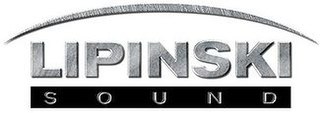
Lipinski Sound is a professional market and audiophile oriented manufacturer of loudspeakers, subwoofers, powered speaker stands, surround sound systems, power amplifiers, microphones, and microphone preamplifiers.
Audio equipment testing is the measurement of audio quality through objective and/or subjective means. The results of such tests are published in journals, magazines, whitepapers, websites, and in other media.
Ambiophonics is a method in the public domain that employs digital signal processing (DSP) and two loudspeakers directly in front of the listener in order to improve reproduction of stereophonic and 5.1 surround sound for music, movies, and games in home theaters, gaming PCs, workstations, or studio monitoring applications. First implemented using mechanical means in 1986, today a number of hardware and VST plug-in makers offer Ambiophonic DSP. Ambiophonics eliminates crosstalk inherent in the conventional stereo triangle speaker placement, and thereby generates a speaker-binaural soundfield that emulates headphone-binaural sound, and creates for the listener improved perception of reality of recorded auditory scenes. A second speaker pair can be added in back in order to enable 360° surround sound reproduction. Additional surround speakers may be used for hall ambience, including height, if desired.
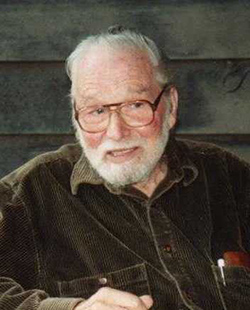
Edgar Marion Villchur was an American inventor, educator, and writer widely known for his 1954 invention of the acoustic suspension loudspeaker which revolutionized the field of high-fidelity equipment. A speaker Villchur developed, the AR-3, is exhibited at The Smithsonian Institution's Information Age Exhibit in Washington, DC.
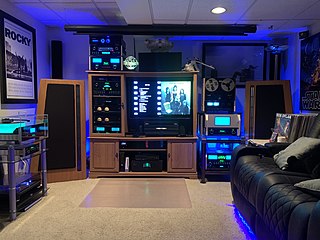
Home audio refer to audio consumer electronics designed for home entertainment, such as integrated systems like shelf stereos, as well as individual components like loudspeakers and surround sound receivers.

Justin Gordon Holt was an audio engineer and the founder of Stereophile magazine, and is widely considered to be the founder of the high-end audio movement, which promoted the philosophy of judging sound quality by subjective tests, generally with "cost no object" sound components, including loudspeakers, turntables, amplifiers, vacuum tube components, cables, and other devices. Known as "JGH", Holt established a reputation for veracity, often-controversial opinions, passionate critiques, and journalistic integrity. He also pioneered the concept of the yearly "Recommended Components" list, providing a thumbnail summary of reviews for audiophiles looking for the finest sound components available at any price. Holt also came up with "Holt's Law," the theory that the better the recording, the worse the musical performance—and vice versa.
Julian David Hirsch was an electrical engineer and audio critic.

The NAD 3020 is a stereo integrated amplifier by NAD Electronics, considered to be one of the most important components in the history of high fidelity audio. Launched in 1978, this highly affordable product delivered a good quality sound, which acquired a reputation as an audiophile amplifier of exceptional value. By 1998, the NAD 3020 had become the most well known and best-selling audio amplifier in history.
Spendor is a British loudspeaker manufacturing company founded in 1969 by audio engineer Spencer Hughes (1924–1983) and his wife Dorothy. It is located in East Sussex. The name was derived from the first names of both.
Michael Alan Fremer is an American music journalist, YouTuber, and voice actor from New York City, known for writing about audiophile equipment and vinyl. He is the editor of The Tracking Angle and Senior Editor at The Absolute Sound. Due to his influence within the audiophile community, he has been called the "Pied Piper of vinyl" and the "dean of audiophile writing."
